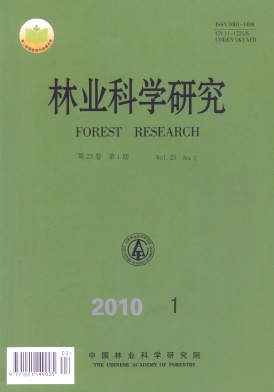|
[1]
|
何承忠, 张志毅, 安新民, 等. 我国杨树育种现状及其展望[J]. 西南林学院学报, 2006, 26(4): 86-89
|
|
[2]
|
方升佐. 中国杨树人工林培育技术研究进展[J]. 应用生态学报, 2008, 19(10): 2308-2316
|
|
[3]
|
马常耕. 从世界杨树杂交育种的发展和成就看我国杨树育种研究[J]. 世界林业研究, 1994, 7(3): 23-29
|
|
[4]
|
张绮纹, 苏晓华, 李金花, 等. 美洲黑杨基因资源收存及遗传评价的研究[J]. 林业科学, 1999, 35(2): 31-37
|
|
[5]
|
马常耕. 我国杨树杂交育种的现状和发展对策[J]. 林业科学, 1995, 31(1): 60-68
|
|
[6]
|
苏晓华, 丁明明, 黄秦军. 外来杨树遗传资源及其存在的问题[J]. 林业科学研究, 2005, 18(6): 743-748
|
|
[7]
|
张忠涛, 孙乐智. 我国的杨树资源与开发利用[J]. 林业建设, 2001 (5): 21-24
|
|
[8]
|
刘 闯. 国内外杨树发展现状与趋势[J]. 辽宁林业科技, 1993 (1): 47-50
|
|
[9]
|
苏晓华, 黄秦军, 张冰玉, 等. 中国杨树良种选育成就及发展对策[J]. 世界林业研究, 2004, 17(1): 46-49
|
|
[10]
|
韩一凡. 美洲黑杨南抗1号、2号新品种选育[J]. 林业科技开发, 1997 (3) :18-20
|
|
[11]
|
黄东森. 中林46 等12个杨树新品种杂交育种——不同气候带杨树育种研究[M]//杨树遗传改良. 北京: 北京农业大学出版社, 1991: 8-38
|
|
[12]
|
潘惠新. 杨树新品种选育研究[J]. 林业科技开发, 2002 (3): 3-4
|
|
[13]
|
朱之悌, 林惠斌, 康向阳. 毛白杨异源三倍体B301 等无性系选育的研究[J]. 林业科学, 1995, 31(6): 499-505
|
|
[14]
|
陈鸿雕, 刘志成, 潘成良, 等. 抗病速生新杂交种辽宁杨、辽河杨、盖杨的选育[J]. 辽宁林业科技, 1995(5): 1-6
|
|
[15]
|
董 雁, 王丽钧, 王玉华, 等. 耐寒、速生杨树新无性系研究[J]. 辽宁林业科技, 1999(2): 6-10
|
|
[16]
|
温宝阳, 周丽君, 李 晶, 等. 杨树新品种——中黑防1、2 号杨[J]. 林业科技通讯, 2000(4): 13-14
|
|
[17]
|
王福森. 杨树新品种——拟青杨×山海关杨选育成功[J]. 防护林科技, 2000(1): 30
|
|
[18]
|
杨自湘, 苏晓华, 黄秦军, 等. 西丰杨系列无性系育种报告[J] 青海农林科技, 2004(S1): 11-13
|
|
[19]
|
王敏杰, 卢孟柱. 林木基因工程育种现状与发展趋势[J].世界林业研究, 2002, 15(3): 7-13
|
|
[20]
|
王学聘, 韩一凡, 戴连韵, 等. 抗虫转基因欧洲美杨的培育[J]. 林业科学, 1997, 33(1): 69-74
|
|
[21]
|
郝贵霞, 朱 祯, 朱之悌. 转CpTI基因毛白杨的获得[J]. 林业科学, 2000, 36(专刊1): 116-119
|
|
[22]
|
饶红宇, 陈 英, 黄敏仁, 等. 杨树NL-80106转Bt基因植物的获得及抗虫性[J]. 植物资源与环境学报, 2000, 9(2): 1-5
|
|
[23]
|
杨传平, 刘桂丰, 梁宏伟, 等. 耐盐基因Bet-1转化小黑杨的研究[J]. 林业科学, 2001, 37(6): 34-38
|
|
[24]
|
刘 斌, 李红双, 王其会, 等. 反义磷脂酶Dr基因转化毛白杨的研究[J].遗传, 2002, 24(1): 40-44
|
|
[25]
|
诸葛强, 王婕琛, 陈 英, 等. 豇豆胰蛋白酶抑制剂(CpTI)抗虫转基因新疆杨的获得[J]. 分子植物育种, 2003, l(4): 491-496
|
|
[26]
|
张冰玉, 苏晓华, 李义良, 等. 转双价抗蛀干害虫基因杨树的获得及其抗虫性鉴定[J]. 林业科学研究, 2005, 18(3): 364-368
|
|
[27]
|
张冰玉, 苏晓华, 李义良, 等. 转抗鞘翅目害虫银腺杨的获得及其抗虫性的初步研究[J]. 北京林业大学学报, 2006, 28(2): 102-105
|
|
[28]
|
Lin T, Wang Z Y, Liu K Y,et al. Transformation of spider neurotoxin gene with prospective insectficidal properties into hybrid poplar Populus simonii ×P. nigra[J]. Acta Entomologica Sinica, 2006, 49(4): 593-598 |
|
[29]
|
卢孟柱,胡建军.我国转基因杨树的研究及应用现状[J].林业科技开发, 2006, 20(6): 1-4
|
|
[30]
|
Wang J G, Su X H, Ji L L. Multiple transgenes Populus × euramericana 'Guariento’ plants obtained by biolistic bombardment[J]. Chinese Science Bulletin, 2007, 52(2): 224-230 |
|
[31]
|
丁明明, 黄秦军, 苏晓华. 欧洲黑杨基因资源材性关联基因的SNP分析[J]. 遗传, 2008, 30(6): 795-800
|
|
[32]
|
黄秦军, 丁明明 , 张香华, 等. SSR标记与欧洲黑杨材性性状的关联分析[J]. 林业科学, 2007, 43(2): 43-47
|
|
[33]
|
黄烈健, 苏晓华, 张香华, 等. 与杨树木材密度、纤维性状相关的SSR分子标记[J]. 遗传学报, 2004, 31(3):299-304
|
|
[34]
|
李金花, 苏晓华, 张绮纹. 用RAPD标记检测与杨树生长和物候期有关的QTLs[J].林业科学研究, 1999, 12(2): 111-117
|
|
[35]
|
苏晓华, 李金花, 陈伯望, 等. 杨树叶片数量性状相关联标记及其图谱定位研究[J]. 林业科学, 2000, 36(1): 33-40
|
|
[36]
|
黄秦军, 苏晓华, 黄烈健, 等. 美洲黑杨 × 青杨木材性状QTLs定位研究[J]. 林业科学, 2004, 40(2): 55-60
|
|
[37]
|
黄秦军, 苏晓华, 张香华. 利用AFLP和SSR标记构建美洲黑杨 × 青杨遗传图谱[J]. 林业科学研究, 2004, 17(3): 291-299
|
|
[38]
|
Tuskan G A, Difazio S, Jansson S, et al. The genome of black cottonwood, Populus trichocarpa
(Tort. &Gray)[J]. Science, 2006, 313 (5793): 1596-1604 |
|
[39]
|
胥 猛, 潘惠新, 张 博, 等. 林木遗传改良中的分子生物学研究进展[J]. 林业科学, 2009, 45(1): 136-143
|
|
[40]
|
徐纬英. 杨树[M]. 哈尔滨: 黑龙江人民出版社, 1988: 14-15
|
|
[41]
|
苏晓华, 张绮纹. 世界杨树杂交育种亲本利用的进展及对策[J]. 世界林业研究, 1992(2): 29-33
|
|
[42]
|
李善文, 张志毅, 何承忠, 等. 中国杨树杂交育种研究进展[J]. 世界林业研究, 2004, 17(2): 37-41
|
|
[43]
|
马常耕. 我国杨树育种中的若干问题商榷[J]. 青海农林科技, 2004(S1): 1-8
|
|
[44]
|
Riemenschneider D E, Stanton B J, Vallee G, et al. Poplar breeding strategies. In: Poplar Culture in North America[M]. Ottawa: NRC CNRC, 2001: 43-76 |
|
[45]
|
Mohrdiek O. Discussion: future possibilities for Poplar breeding[J]. Can J For Res, 1983, 13: 465-471 |
|
[46]
|
Stettler R F, Brdshaw H D, Heilman P E, et al. Biology of Populus[M]. Ottawa: NRC CNRC, 1996: 139-155 |
|
[47]
|
Bisoffi S, Gulberg U. Poplar breeding and selection strategies. In: Biology of Populus and its implications for management and conservation[M]. Ottawa: NRC CNRC, 1996: 139-158 |
|
[48]
|
Stanton B J. The effect of reciprocal hybridization on reproduction of the intersectional cross, Populus × generosa[J]. Forest Genetics, 2005, 12: 131-140 |
|
[49]
|
Wheeler N, Payne P, Hipkins V, et al. Polymix breeding with paternity analysis in Populus: a test for differential reproductive success (DRS) among pollen donors[J]. Tree Genetics and Genomes, 2006, 2: 53-60 |
|
[50]
|
Dungey H S. Pine hybrids-a review of their use performance and genetics[J]. For. Ecol and Manag, 2001, 148: 243-258 |
|
[51]
|
Kerr R J, Dieters M J, Tier B. Simulation of the comparative gains from four different hybrid tree breeding strategies[J]. Can For Res, 2004, 34: 209-220 |
|
[52]
|
Dario G. Marker-assisted selection in Eucalyptus. In: Marker-Assisted Selection: Current status and future perspectives in crops, livestock, forestry and fish[M]. Rome: Food and Agriculture Organization of the United Nations, 2007: 252-281 |
|
[53]
|
郭龙彪, 程式华, 钱 前. 水稻基因设计育种的研究进展与展望[J]. 中国水稻科学, 2008, 22(6): 650-657
|
|
[54]
|
钱 前, 郭龙彪, 杨长登. 水稻基因设计育种[M]. 北京: 科学出版社, 2007
|
|
[55]
|
Grattapaglia D, Plomion C, Kirst M, et al. Genomics of growth traits in forest trees[J]. Curr Opin Plant Biol, 2009, 12:148-156 |





 DownLoad:
DownLoad: